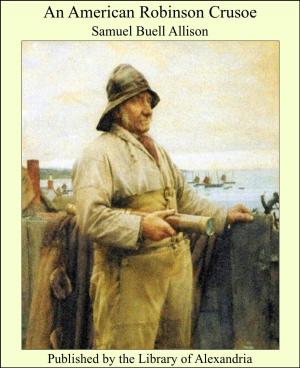A Man by the Name of Ziegler
Nonfiction, Religion & Spirituality, New Age, History, Fiction & Literature| Author: | Hermann Hesse | ISBN: | 9781465572271 |
| Publisher: | Library of Alexandria | Publication: | July 29, 2009 |
| Imprint: | Library of Alexandria | Language: | English |
| Author: | Hermann Hesse |
| ISBN: | 9781465572271 |
| Publisher: | Library of Alexandria |
| Publication: | July 29, 2009 |
| Imprint: | Library of Alexandria |
| Language: | English |
Springtime in the mountains. Graceful slopes and frowning precipices robed in darkest green of hemlock and spruce. Open fields here and there verdant with young grass and springing grain, or moist and brown beneath the plow for the planting time. Hedgerow and underwood fragrant with honeysuckle and wild blackberry bloom; violets and geraniums purpling the forest floor. Conemaugh creek and Stony creek dash and plunge and foam along their rocky channels to where they unite their waters and form the Conemaugh river, hastening down to the Ohio, to the Mississippi, to the Mexican Gulf. Trout and pickerel and bass flash their bronze and silver armor in the sparkling shallows of the streams and in the sombre and placid depths of the lake up yonder behind the old mud dam. Along the valley of the Conemaugh are ranged villages, towns, cities: Conemaugh, Johnstown, Cambria, Sang Hollow, Nineveh, and others, happy and prosperous. Conemaugh nestles at the very foot of the Alleghenies; all railroad trains eastward bound stop there to catch their breath before beginning the long climb up to Altoona. Sang Hollow nestles by the river amid almost tropical luxuriance of vegetation; yon little wooded islet in mid-stream a favorite haunt of fishermen. Nineveh is rich in bog iron and coal, and the whirr of the mill-wheel is heard. Johnstown, between the two creeks at their junction, is the queen city of the valley. On either side the creek, and beyond, the steep mountain sides; behind, the narrow valley reaching twenty miles back to the lake; before, the Conemaugh river just beginning its romantic course. Broken hillsides streaked with torrents encompass it. Just a century ago was Johnstown founded by one Joseph Johns, a German settler. Before then its beauteous site was occupied by an Indian village, Kickenapawling. Below this was the head of navigation on the Conemaugh. Hither came the wagoners of the Alleghenies, with huge wains piled high with merchandise from seaboard cities, and placed it on flat-bottomed boats and started it down the river-way to the western markets. The merchandise came up from Philadelphia and Baltimore by river, too; up the Susquehanna and Juniata, to the eastern foot-hills, and there was a great portage from the Juniata to the Conemaugh; the Kittanning Trail, then the Frankstown Turnpike. Later came the great trunk railroad whose express trains now go roaring down the valley. Johnstown is—nay, Johnstown was!—a busy and industrious place. The people of the town were the employees of the Cambria Iron and Steel Company, their families, and small storekeepers. There was not one rich man in the town. Three-quarters of the 28,000 people lived in small frame tenement houses on the flats by the river around the works of the Cambria Company. The Cambria Company owns almost all the land, and the business and professional men and the superintendents of the company live on the hills away up from the creeks. The creeks become the Conemaugh river right at the end of the town, near where the big stone Pennsylvania Railroad bridge crosses the river. The borough of Johnstown was on the south bank of Conemaugh creek, and the east bank of Stony creek, right in the fork. It had only about a third of the population of the place. It had never been incorporated with the surrounding villages, as the Cambria Company, which owned most of the villages and only part of Johnstown, did not wish to have them consolidated into one city. Conemaugh was the largest village on the creek between the lake and Johnstown. It is often spoken of as part of Johnstown, though its railroad station is two or three miles up the creek from the Johnstown station. The streets of the two towns run into each other, and the space between the two stations is well built up along the creek. Part of the Cambria Iron and Steel Company’s works are at Conemaugh, and five or six thousand of the workingmen and their families lived there. The business was done in Johnstown borough, where almost all the stores of Johnstown city were
Springtime in the mountains. Graceful slopes and frowning precipices robed in darkest green of hemlock and spruce. Open fields here and there verdant with young grass and springing grain, or moist and brown beneath the plow for the planting time. Hedgerow and underwood fragrant with honeysuckle and wild blackberry bloom; violets and geraniums purpling the forest floor. Conemaugh creek and Stony creek dash and plunge and foam along their rocky channels to where they unite their waters and form the Conemaugh river, hastening down to the Ohio, to the Mississippi, to the Mexican Gulf. Trout and pickerel and bass flash their bronze and silver armor in the sparkling shallows of the streams and in the sombre and placid depths of the lake up yonder behind the old mud dam. Along the valley of the Conemaugh are ranged villages, towns, cities: Conemaugh, Johnstown, Cambria, Sang Hollow, Nineveh, and others, happy and prosperous. Conemaugh nestles at the very foot of the Alleghenies; all railroad trains eastward bound stop there to catch their breath before beginning the long climb up to Altoona. Sang Hollow nestles by the river amid almost tropical luxuriance of vegetation; yon little wooded islet in mid-stream a favorite haunt of fishermen. Nineveh is rich in bog iron and coal, and the whirr of the mill-wheel is heard. Johnstown, between the two creeks at their junction, is the queen city of the valley. On either side the creek, and beyond, the steep mountain sides; behind, the narrow valley reaching twenty miles back to the lake; before, the Conemaugh river just beginning its romantic course. Broken hillsides streaked with torrents encompass it. Just a century ago was Johnstown founded by one Joseph Johns, a German settler. Before then its beauteous site was occupied by an Indian village, Kickenapawling. Below this was the head of navigation on the Conemaugh. Hither came the wagoners of the Alleghenies, with huge wains piled high with merchandise from seaboard cities, and placed it on flat-bottomed boats and started it down the river-way to the western markets. The merchandise came up from Philadelphia and Baltimore by river, too; up the Susquehanna and Juniata, to the eastern foot-hills, and there was a great portage from the Juniata to the Conemaugh; the Kittanning Trail, then the Frankstown Turnpike. Later came the great trunk railroad whose express trains now go roaring down the valley. Johnstown is—nay, Johnstown was!—a busy and industrious place. The people of the town were the employees of the Cambria Iron and Steel Company, their families, and small storekeepers. There was not one rich man in the town. Three-quarters of the 28,000 people lived in small frame tenement houses on the flats by the river around the works of the Cambria Company. The Cambria Company owns almost all the land, and the business and professional men and the superintendents of the company live on the hills away up from the creeks. The creeks become the Conemaugh river right at the end of the town, near where the big stone Pennsylvania Railroad bridge crosses the river. The borough of Johnstown was on the south bank of Conemaugh creek, and the east bank of Stony creek, right in the fork. It had only about a third of the population of the place. It had never been incorporated with the surrounding villages, as the Cambria Company, which owned most of the villages and only part of Johnstown, did not wish to have them consolidated into one city. Conemaugh was the largest village on the creek between the lake and Johnstown. It is often spoken of as part of Johnstown, though its railroad station is two or three miles up the creek from the Johnstown station. The streets of the two towns run into each other, and the space between the two stations is well built up along the creek. Part of the Cambria Iron and Steel Company’s works are at Conemaugh, and five or six thousand of the workingmen and their families lived there. The business was done in Johnstown borough, where almost all the stores of Johnstown city were















